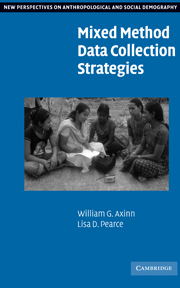Book contents
- Frontmatter
- Contents
- Acknowledgments
- Preface
- 1 Motivations for Mixed Method Social Research
- 2 Fitting Data Collection Methods to Research Aims
- 3 The Micro-Demographic Community Study Approach
- 4 Systematic Anomalous Case Analysis
- 5 Neighborhood History Calendars
- 6 Life History Calendars
- 7 Longitudinal Data Collection
- 8 Conclusion
- Notes
- Bibliography
- Index
4 - Systematic Anomalous Case Analysis
Published online by Cambridge University Press: 10 December 2009
- Frontmatter
- Contents
- Acknowledgments
- Preface
- 1 Motivations for Mixed Method Social Research
- 2 Fitting Data Collection Methods to Research Aims
- 3 The Micro-Demographic Community Study Approach
- 4 Systematic Anomalous Case Analysis
- 5 Neighborhood History Calendars
- 6 Life History Calendars
- 7 Longitudinal Data Collection
- 8 Conclusion
- Notes
- Bibliography
- Index
Summary
Like the previous chapter, this chapter describes a specific application of mixed method research. This application is less an overall project model and more a piece of the research project in which existing data facilitate a fieldwork project that produces findings with the potential for informing further survey analyses and data collections. It is a focused description of the back and forth between more structured and less structured research methods that can develop progress toward understanding certain social processes further than one method alone might achieve (Sieber 1973). This chapter also differs from the first in that it could more realistically be applied to other questions and settings by one researcher on a smaller scale than the previous chapter's example. However, having existing survey data to use and permission to recontact respondents is necessary, and these issues are addressed at the end of this chapter.
The approach we present here is rooted in ideas about the social scientific process that have been around for some time. Kendall and Wolf (1949) suggest: “Through careful analysis of the cases that do not exhibit the expected behavior, the researcher recognizes the oversimplification of his or her theoretical structure and becomes aware of the need for incorporating further variables into the predictive scheme” (pp. 153–4). Commenting on this, Sieber (1973) writes: “But often the researcher does not have in hand the additional information necessary for measuring the further variables.
- Type
- Chapter
- Information
- Mixed Method Data Collection Strategies , pp. 79 - 102Publisher: Cambridge University PressPrint publication year: 2006
- 1
- Cited by



